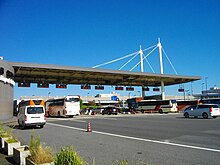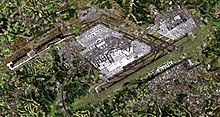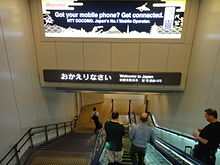Tokyo Narita Airport
| Narita Kokusai Kūkō |
|
|---|---|

|
|
| Characteristics | |
| ICAO code | RJAA |
| IATA code | NRT |
| Coordinates | |
| Height above MSL | 41 m (135 ft ) |
| Transport links | |
| Distance from the city center | 66 km northeast of Tokyo |
| train | JR Narita Express (N'EX), JR Narita Airport , Keisei Main Line , Keisei Narita Sky Access |
| Local transport | Taxi, Airport Limousine Bus |
| Basic data | |
| opening | 1978 |
| operator | Narita International Airport Corporation |
| surface | 940 ha |
| Terminals | 3 |
| Passengers | 39,053,652 (2016) |
| Air freight | 2,083,220 t (2016) |
| Flight movements |
243,474 (2016) |
| Employees | 46,000 |
| Runways | |
| 16R / 34L | 4000 m × 60 m asphalt |
| 16L / 34R | 2500 m × 60 m asphalt |
The Narita International Airport ( Jap. 成田国際空港 Narita Kokusai Kuko , dt "Narita International Airport"; official. Narita International Airport , formerly New Tokyo International Airport ; IATA airport code: NRT ICAO airport code: RJAA) is one Tokyo International Airports and is a 1st class airport under Japanese law . In Japan, it is usually as Narita Airport (Jap. 成田空港 Narita Kuko ) because the airport in the city of Narita in the prefecture of Chiba is located about 60 kilometers northeast of Tokyo. With around 36 million passengers in 2014, it is the second largest airport in Japan and ranked 45th worldwide . In addition, with a cargo volume of around two million tons in 2013, it is the tenth largest cargo airport in the world.
The airport serves as a hub for the airlines All Nippon Airways , Japan Airlines , Nippon Cargo Airlines , Air Japan , Delta Air Lines , United Airlines , Peach Aviation , Jetstar Japan , Vanilla Air and Spring Airlines Japan .
history
Japan's economy grew strongly in the 1950s and 1960s , and the number of passengers at Tokyo's Haneda Airport, which opened in 1931, rose accordingly . In 1962 it was decided to build a new airport for the capital, New Tokyo International Airport , which was to take over international traffic from Haneda, while domestic traffic was to remain at the old airport, which was relatively close to the city center.
Construction began in 1971, but met with strong opposition from the population due to land expropriation, which is unusual in Japan. Around 1966, residents, farmers, students and left-wing parties formed the "Sanrizuka-Shibayama Rengo Kūkō Hantai Dōmei" (Japanese 三 里 塚 ・ 芝山 連 合 空港 反 対 同盟 , English Sanrikuza Shibayama Association against the airport ), which is famous in Japan 1983 lasted. She repeatedly protested against the construction of the airport and, for example, set up roadblocks in 1967 so that the Ministry of Transport was prevented from surveying the airport. The organization Zengakuren also sent students to support the farmers in their protests. The first terminal was completed in 1972, but completion of the runway was delayed for several years as several farmers refused to leave their properties. The opening date was finally set for March 30, 1978, but had to be postponed because a group of activists stormed the tower on March 26 and destroyed important parts of the complex. So the airport could only be opened on May 20, 1978 with only one runway. The airport was fenced in that day and guarded by 14,000 police officers. 6000 opponents attacked the police with stones and incendiary bombs, whereupon they fought back with water cannons. At the other end of Tokyo, activists cut power to a district control post in Tokorozawa . This severely affected air traffic in the Kantō region for a few hours.
The second runway was not put into operation until 2002 (after the decision was made in 1986). This could only be partially opened, however, because this time land expropriations were waived and a local poultry farmer refused to leave his farm in the area. Initially, the new run was only 2100 meters long. In September 2008, construction began to extend it to 2500 m and to expand the taxiways and parking areas, which have been completed since October 2009. The plans for a third runway with a length of 3200 meters have been put on hold until further notice.
Narita is considered one of the most expensive airports in the world as a result of the protests during the construction, which can still be felt in the demonstrations that are still taking place. Until 2015, security checks were also carried out when entering the airport premises in order to prevent possible attacks by opponents. The landing fees for a Boeing 747 were once 948,000 yen (about 7600 euros ), but were reduced to 730,750 yen (5800 euros) on October 1, 2005. For comparison: the landing fees for this aircraft at Kansai Airport cost 825,600 yen (6600 euros), at Incheon Airport ( South Korea ) only the equivalent of 322,000 (2600 euros) and in Hong Kong only 374,000 yen (3000 euros). As a result, these airports have been able to expand their position as an East Asian hub very significantly in recent years, while Narita's passenger numbers have practically stagnated since 2004.
The airport operator "New Tokyo International Airport Authority" (Japanese 新 東京 国際 空港 公 団 Shin Tōkyō Kokusai Kūkō Kōdan ) was on April 1, 2004 in the public stock corporation Narita International Airport Corporation (Japanese 成 田 国際 空港 株式会社 Narita Kokusai Kūkō Kabushiki Gaisha ) converted (previously state special fund), which is 100 percent owned by the state. At the same time, the airport was renamed from “New Tokyo International Airport” to “Narita International Airport” that day.
As a result of high costs, long transfer times (1.5 hours to the domestic airport Haneda and the city center of Tokyo) and the high fuel costs as well as the economic crisis in 2008, the number of passengers fell from over 35 million in 2007 to 33, 8 million, although the airport has nevertheless reached its capacity limit. Freight transport fell particularly sharply during this period. For this reason, the terminals for the Airbus A380 were modernized and more parking spaces created for the aircraft. In July 2010, the Narita Sky Access high-speed rail line was opened and since then the Keisei Dentetsu Skyliner trains have been running to the city center.
Airport facilities
The airport has three terminals. Terminal 1 was opened in 1978, Terminal 2 in 1992 and Terminal 3 in 2015. Tokyo-Narita was one of the first airports to be divided into the three aviation alliances Star Alliance , Oneworld Alliance and SkyTeam .
Terminal 1
Terminal 1 is divided into the “North Wing”, “Central Building” and “South Wing” areas. Two satellites are connected to the North Wing and the Central Building , and one to the South Wing. The North Wing is used by the airlines of the alliance SkyTeam and the non-alliance Aircalin . The South Wing serves the Star Alliance as well as the airlines Air Busan , MIAT Mongolian Airlines , Uzbekistan Airways and Etihad Airways .
Terminal 2
Terminal 2 is divided into a main building and a satellite. These were connected to a people mover until 2013 , which was replaced by a sidewalk. The terminal is used by the Oneworld Alliance and non-alliance airlines such as Emirates , Philippine Airlines and Pakistan International Airlines .
Terminal 3
Terminal 3 is 66,000 square meters and is used exclusively by low-cost airlines. The interior is modest and the floor is reminiscent of a running track.
Other bodies
The cargo airline Nippon Cargo Airlines is based in the "NCA Line Maintenance Hangar" (Japanese NCA ラ イ ン 整 備 ハ ン ガ ー NCA Rain Seibi Hangā ). Japan Airlines owns the "Japan Airlines Narita Operation Center" (Japanese 日本 航空 成 田 オ ペ レ ー シ ョ ン セ ン タ ー Nihon Kōkū Narita Operēshon Sentā ), where the former subsidiary JALways also had its headquarters. Furthermore, the only fully automatic washing facility for aircraft in the world is currently located on the airport premises.
The aviation museum "Museum of Aeronautical Sciences" (Japanese 航空 科学 博物館 Kōkū Kagaku Hakubutsukan ) is located in the southern part of the airport and provides u. a. the prototype of the NAMC YS-11 .
Airlines and Destinations
The “North Wing” of Terminal 1 is served by Aeroflot , Aeroméxico , Aircalin , Air France , Alitalia , Aurora Airlines , China Southern Airlines , Delta Air Lines , Garuda Indonesia , KLM Royal Dutch Airlines , Korean Air , Vietnam Airlines and Xiamen Airlines ; the "South Wing" of Air Busan , Air Canada , Air China , Air Japan , Air New Zealand , All Nippon Airways , Asiana Airlines , Austrian Airlines , Egypt Air , Ethiopian Airlines , Etihad Airways , EVA Air , Ibex Airlines , MIAT Mongolian Airlines , Peach Aviation , SAS Scandinavian Airlines , Shenzhen Airlines , Singapore Airlines , Swiss , Thai Airways International , Turkish Airlines , United Airlines and Uzbekistan Airways .
Terminal 2 is served by Air India , Air Macau , Air Niugini , Air Tahiti Nui , American Airlines , Asia Atlantic Airlines , Asian Air , British Airways , Cathay Pacific , Cebu Pacific , China Airlines , China Eastern , Eastar Jet , Emirates , Finnair , HK Express , Japan Airlines , Jet Asia Airways , Malaysia Airlines , Pakistan International Airlines , Philippine Airlines , Qantas Airways , Qatar Airways , S7 Airlines , Scoot , SriLankan Airlines , Thai AirAsia X , Tigerair Taiwan and TransAsia Airways .
Terminal 3 is served by Jeju Air , Jetstar Airways , Jetstar Japan , Spring Airlines Japan and Vanilla Air .
In addition, the cargo airlines Air China Cargo , Air France Cargo, Air Hong Kong , AirBridgeCargo , ANA Cargo, Cathay Pacific Cargo, China Airlines Cargo, China Cargo Airlines , Atlas Air , Emirates SkyCargo, FedEx , Hong Kong Airlines Cargo, KLM Cargo, Korean Air Cargo, Lufthansa Cargo , MASkargo, Nippon Cargo Airlines , Singapore Airlines Cargo , Southern Air , Thai Cargo and UPS Airlines .
In German-speaking countries, Japan Airlines flies to Frankfurt am Main , All Nippon Airways to Düsseldorf , Swiss to Zurich and Austrian to Vienna seasonally .
Basic data
Passenger volume
- 1978: 4.87 million
- 2002: 29.10 million
- 2003: 26.73 million
- 2004: 31.22 million
- 2005: 31.55 million
- 2006: 31.82 million
- 2007: 35.56 million
- 2008: 33.50 million
- 2009: 32.21 million
- 2010: 33.87 million
- 2011: 28.07 million
- 2012: 32.79 million
- 2013: 35.38 million
- 2014: 35.59 million
- 2015: 37.32 million
- 2016: 39.05 million
Flight movements
- 1978: 36,689
- 2002: 163.131
- 2003: 170.579
- 2004: 185.243
- 2005: 188.275
- 2006: 188.820
- 2007: 193.748
- 2008: 193,321
- 2009: 187.287
- 2010: 191,459
- 2011: 183,450
- 2012: 208,704
- 2013: 221,692
- 2014: 229,581
- 2015: 232.182
- 2016: 243,474
Transport links
Connections to Haneda Airport
It takes about 1.5 to 2 hours to get to Tokyo Haneda Airport by bus or train. The Keisei Electric Railway operates a train compound which travels the route in 101 minutes; Airport Transport Service buses reach Haneda in 65–85 minutes.
Rail transport
Tokyo-Narita is connected to the rail network of the East Japan Railway Company and Keisei Dentetsu. The station Narita Airport Station with Terminal 1 and Airport Terminal 2 Station connected to the terminal. 2 The Narita Express runs on the Sōbu Main Line and Narita Line to Tokyo Station . The train splits there and runs on the Shōnan-Shinjuku line to Shibuya , Shinjuku , Ikebukuro , Ōmiya-ku and Hachiōji and on the Yokosuka line to Shinagawa , Yokohama and Kamakura . Keisei offers the fastest connection to Tokyo Station with the Skyliner on the Narita airport line with a journey time of 50 minutes. The City Liner also goes there on the Keisei main line from the airport.
Road traffic
There are bus connections to many places in the Kantō region , which are operated by various bus companies. It takes about 55 minutes to get to the Tokyo City Air Terminal station in Nihombashi from the airport.
Incidents
- On Monday, March 23, 2009, the FedEx cargo plane of the type McDonnell Douglas MD-11 with the aircraft registration number N526FE coming from Guangzhou , China , crashed on landing. Surveillance cameras documented that the main landing gear of the aircraft touched down hard on the runway, whereupon it jumped again. Then it touched down with the nose landing gear first, overturned and caught fire. According to preliminary reports, squalls of up to 72 km / h are the cause of the accident. The two pilots died in the accident.
Trivia
- A term common in Japan is “Narita divorce” ( 成 田 離婚 , Narita rikon ), which alludes to the divorces that often follow Japanese newlyweds' honeymoons abroad, in which the couples often find their first time outside of everyday life and the domestic social control "sit on top of each other" for a long time and discover that they don't go together after all. Narita Rikon is also the title of a multi-part television comedy that was broadcast in Japan in the late autumn of 1997 and is based on this social phenomenon.
- At the end of 2009, the case of the Chinese human rights activist Feng Zhenghu received international attention: China repeatedly refused him re-entry, after which he did not leave the immigration area of Tokyo Narita Airport for months.
See also
Web links
Individual evidence
- ↑ a b c Monthly Traffic Statistics - 2016 ( Memento of the original from January 26, 2017 in the Internet Archive ) Info: The archive link was inserted automatically and has not yet been checked. Please check the original and archive link according to the instructions and then remove this notice.
- ↑ FlugRevue April 2009, pp. 63–65, Narita International Airport - Cramped Gate to Japan
- ↑ Video of the crash on Spiegel-Online
- ↑ Chinese human rights activist stuck at Tokyo airport . In: The Guardian , November 13, 2009.



















